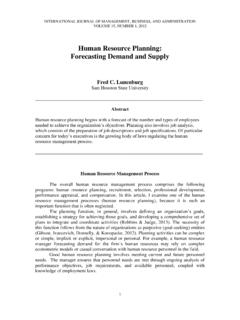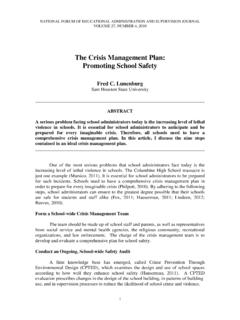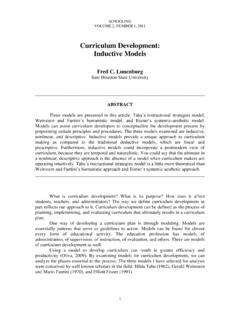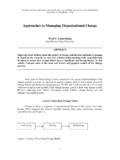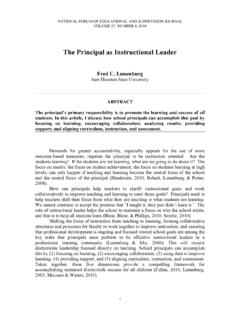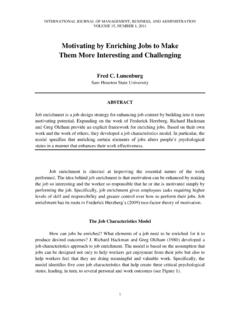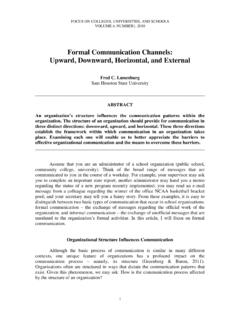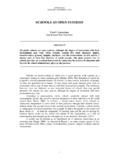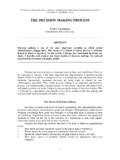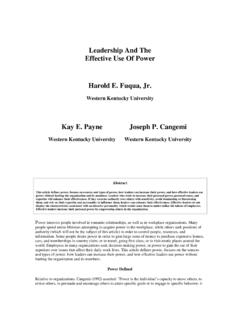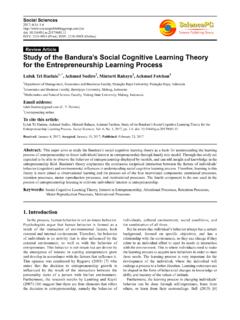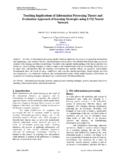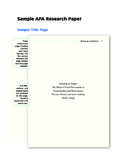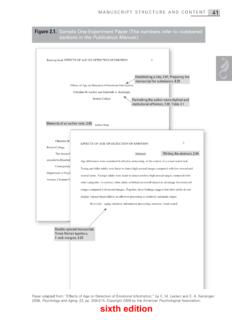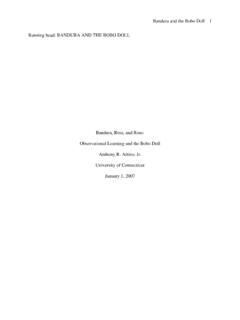Transcription of Comparison of Change Theories - National Forum
1 INTERNATIONAL JOURNAL OF MANAGEMENT, BUSINESS, AND ADMINISTRATION VOLUME 8, NUMBER 1, 2005 1 Comparison of Change Theories Alicia Kritsonis MBA Graduate Student California State University, Dominquez Hills ABSTRACT The purpose of this article is to summarize several Change Theories and assumptions about the nature of Change . The author shows how successful Change can be encouraged and facilitated for long-term success. The article compares the characteristics of Lewin s Three-Step Change theory , Lippitt s Phases of Change theory , Prochaska and DiClemente s Change theory , Social Cognitive theory , and the theory of Reasoned Action and Planned Behavior to one another.
2 Leading industry experts will need to continually review and provide new information relative to the Change process and to our evolving society and culture. here are many Change Theories and some of the most widely recognized are briefly summarized in this article. The Theories serve as a testimony to the fact that Change is a real phenomenon. It can be observed and analyzed through various steps or phases. The Theories have been conceptualized to answer the question, How does successful Change happen? Lewin s Three-Step Change theory Kurt Lewin (1951) introduced the three-step Change model. This social scientist views behavior as a dynamic balance of forces working in opposing directions.
3 Driving forces facilitate Change because they push employees in the desired direction. Restraining forces hinder Change because they push employees in the opposite direction. Therefore, these forces must be analyzed and Lewin s three-step model can help shift the balance in the direction of the planned Change ( ~jvgrizzell/best_ ). T INTERNATIONAL JOURNAL OF MNAGEMENT, BUSINESS, AND ADMINISTRATION 2_____ According to Lewin, the first step in the process of changing behavior is to unfreeze the existing situation or status quo. The status quo is considered the equilibrium state. Unfreezing is necessary to overcome the strains of individual resistance and group conformity. Unfreezing can be achieved by the use of three methods.
4 First, increase the driving forces that direct behavior away from the existing situation or status quo. Second, decrease the restraining forces that negatively affect the movement from the existing equilibrium. Third, find a combination of the two methods listed above. Some activities that can assist in the unfreezing step include: motivate participants by preparing them for Change , build trust and recognition for the need to Change , and actively participate in recognizing problems and brainstorming solutions within a group (Robbins 564-65). Lewin s second step in the process of changing behavior is movement. In this step, it is necessary to move the target system to a new level of equilibrium.
5 Three actions that can assist in the movement step include: persuading employees to agree that the status quo is not beneficial to them and encouraging them to view the problem from a fresh perspective, work together on a quest for new, relevant information, and connect the views of the group to well-respected, powerful leaders that also support the Change ( ~jvgrizzell/best_ ). The third step of Lewin s three-step Change model is refreezing. This step needs to take place after the Change has been implemented in order for it to be sustained or stick over time. It is high likely that the Change will be short lived and the employees will revert to their old equilibrium (behaviors) if this step is not taken.
6 It is the actual integration of the new values into the community values and traditions. The purpose of refreezing is to stabilize the new equilibrium resulting from the Change by balancing both the driving and restraining forces. One action that can be used to implement Lewin s third step is to reinforce new patterns and institutionalize them through formal and informal mechanisms including policies and procedures (Robbins 564-65). Therefore, Lewin s model illustrates the effects of forces that either promote or inhibit Change . Specifically, driving forces promote Change while restraining forces oppose Change . Hence, Change will occur when the combined strength of one force is greater than the combined strength of the opposing set of forces (Robbins 564-65).
7 Lippitt s Phases of Change theory Lippitt, Watson, and Westley (1958) extend Lewin s Three-Step Change theory . Lippitt, Watson, and Westley created a seven-step theory that focuses more on the role and responsibility of the Change agent than on the evolution of the Change itself. Information is continuously exchanged throughout the process. The seven steps are: ALICIA KRITSONIS _____3 1. Diagnose the problem. 2. Assess the motivation and capacity for Change . 3. Assess the resources and motivation of the Change agent. This includes the Change agent s commitment to Change , power, and stamina. 4. Choose progressive Change objects. In this step, action plans are developed and strategies are established.
8 5. The role of the Change agents should be selected and clearly understood by all parties so that expectations are clear. Examples of roles are: cheerleader, facilitator, and expert. 6. Maintain the Change . Communication, feedback, and group coordination are essential elements in this step of the Change process. 7. Gradually terminate from the helping relationship. The Change agent should gradually withdraw from their role over time. This will occur when the Change becomes part of the organizational culture (Lippitt, Watson and Westley 58-59). Lippitt, Watson, and Westley point out that changes are more likely to be stable if they spread to neighboring systems or to subparts of the system immediately affected.
9 Changes are better rooted. Two examples are: the individual meets other problems in a similar way, several businesses adopt the same innovation, or the problem spreads to other departments of the same business. The more widespread imitation becomes, the more the behavior is regarded as normal (Lippitt, Watson and Westley 58-59). Prochaska and DiClemente s Change theory Initially, the purpose of Prochaska and DiClemente model of Change behavior was to show where a patient was in their journey to Change certain health behaviors. Throughout the years, this model has been extended to other audiences other than solely health patients. The model defines a more general process of Change and, therefore, it tends to be less specific.
10 Prochaska and DiClemente found that people pass through a series of stages when Change occurs. The stages discussed in their Change theory are: precontempation, contemplation, preparation, action, and maintenance. Progression through the stages is cyclical, not linear. This is because initially many individuals relapse on their Change efforts and do not successfully maintain their gains the first time around (Hicks 1). Prochaska and DiClemente have created a spiral model to represent the various stages of their theory . The first aspect of the model shows the movement of intentional Change from precontemplation to contemplation of the issue. Precontemplation exists when an individual is unaware or fails to acknowledge the problems without engaging in any Change process activities.
